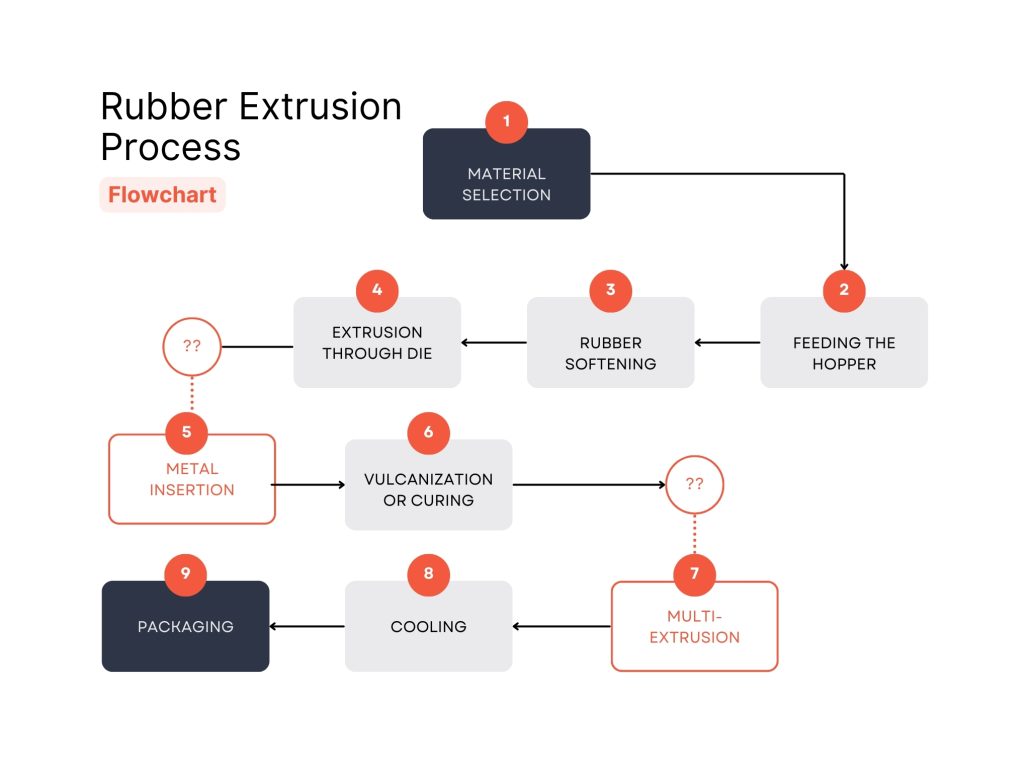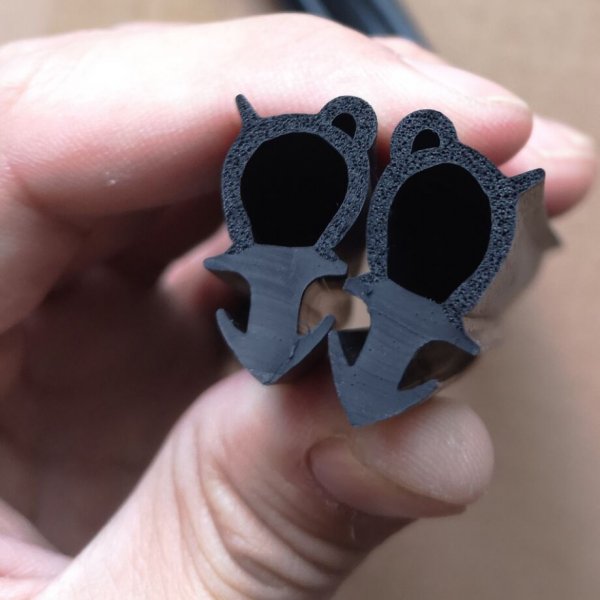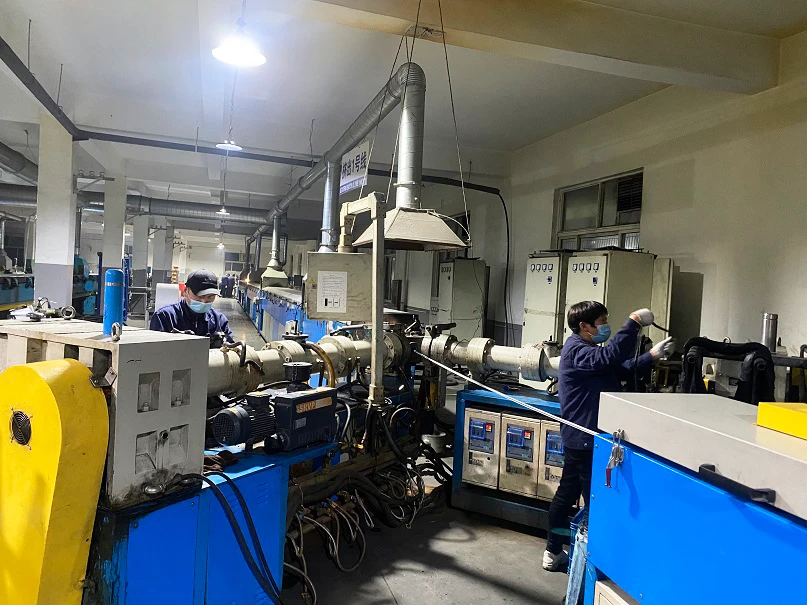Rubber extrusion is the most used technique in rubber manufacturing. Although rubber molding is also used in many situations, the rubber extrusion process is the most popular.
The rubber extrusion process is widely used in many industries, from the car industry to construction. Why is rubber extrusion better than molding? There are several reasons, among which high productivity is the primary one. Besides, this method is also flexible and produces durable rubber parts. You will learn more about it in the following few sections.
This article mainly focuses on the fundamentals of the rubber extrusion process. You will learn what it is and what the step-by-step factory process is. This step-by-step process tells you what factors to consider when choosing suitable rubber products. In addition, you will learn how rubber extrusion differs from rubber molding.

What is the Rubber Extrusion Process?
Rubber extrusion is a rubber manufacturing process often used in rubber industries. This method involves shaping rubber into various shapes, mostly rubber profiles.
According to the definition, a rubber extrusion process produces rubber profiles with the same cross-sectional area. Because of this method, rubber profiles get several properties. They are:
(1) This process produces long, continuous lengths of rubber profiles. Because of this, the consistency of the profile remains the same along the entire length.
(2) You can create complex shapes using custom dies.
(3) You can also improve the softness of the rubber product. It depends mainly on the curing method and type of rubber used.
(4) This method produces long, unbroken rubber profiles with the same cross-section area. This type of profile is especially ideal for sealing. You can use it as weatherstripping or gaskets.
(5) The rubber extrusion process typically allows you to make high production.
Rubber Extrusion Process Applications
The rubber extrusion process produces many everyday products. One of the best examples is seal strips, which people also recognize as weather stripping. This product is widely used in doors and windows. Rubber tubing is ideal for fluid transfer. Besides, various gaskets used in machines or equipment are also made of rubber.
Why Rubber Extrusions are better than molds?
Both methods are widely popular in the rubber industry. Yet, they have some suitability issues. In this section, you will learn in which case the rubber extrusion process is a better option.
Reason #1. Cost-effective and Faster Production for Long Runs
As you are aware, rubber extrusion is a continuous process. When you start the gadget, it will continuously manufacture lengthy rubber profiles. In contrast, you must push the molten rubber into the mold for each product in rubber molding. As a result, the rubber extrusion process is both cost-effective and efficient.
Reason #2. The Most Efficient Method for Simple Shapes
The rubber extrusion method is suitable for a moderate level of complexity or simplicity in the particular product’s design. It can be applied to make continuous seals, gaskets, and tubing. On the other hand, rubber molding is ideal for creating intricate rubber product shapes.
Reason #3. Almost Zero Material Waste
The rubber extrusion method produces almost zero waste. The rubber extruder pushes the molten rubber into the die, producing long rubber profiles. Later, you can cut them to length based on your needs.
Reason #4. Ability to Make Custom Lengths
As already said, rubber extruders produce long rubber profiles. There are no specific lengths for this method. Instead, you can choose it based on your project needs. On the other hand, rubber molding can not offer this benefit.
Reason #6. Less Tooling Cost
Rubber extrusion is a significantly cheaper technology than rubber molding. You’ll also require less money for tooling. However, rubber molding is appropriate for intricate designs. As a result, the tooling design is likewise pricey.

Step-By-Step Rubber Extrusion Process
Throughout our discussion, we’ve provided insights into how the extrusion process works. You will learn this section step by step. In each phase, you may picture how the production process works. You can also look at the aspects that affect the overall quality of your products.
Step #1 Material Selection and Preparation
First, we have to select suitable rubber material. You might have endless choices. For instance, silicone rubber is more suited to high-temperature applications than EPDM rubber, which is more suited for applications such as weather strips. Neoprene and nitrile may be your best chances at standing up to chemicals.
Step #2 Feeding the Extruder
After the suitable rubber has been chosen, it is put in the extruder hopper. You will find three main parts if you disassemble a rubber extruder machine. (1) The insertion chamber, (2) the processing chamber, and (3) The extrusion chamber. You can find the hopper in the first chamber.
Step #3 Rubber Softening and Mixing
Once the hopper takes the material, it passes to the processing section. In the processing section, there’s a large screw which gradually pushes the rubber forward. Here, there’s also a consistent heating system. So, When the rubber moves forward, at the same time, it gets softer because of the heat.
Step #4 Extrusion Through Die
The rubber extruder machine then gradually pushes the soft rubber material to the die. Because of the die, the rubber gets a specific shape with the same cross-section area. It continues to do so until the rubber inside the machine is finished.

Step #5 Metal Insertion (If needed)
Rubber extrusion profiles are used for many purposes. They seal doors, windows, and even heavy-duty machinery. So, the strength of the rubber profile is a very important parameter here. You can achieve this by simply inserting metals in the rubber profiles. And you can do it during this rubber extrusion process.
Step #6 Vulcanization or Curing
Once the extruded rubber comes out of the rubber extruder machine, it remains soft. In this situation, a unique method called vulcanization—also known as a curing method—is used to strengthen these rubber profiles.

Step #7 Multi-extrusion (if required)
Sometimes, your product may need more than one color or material. The best example is the dual durometer rubber extrusion profile. Besides, many rubber products require more than one rubber extrusion process.
Step #8 Cooling
After the vulcanization process, cooling begins. This generally cools down the rubber profile and makes it harder. To avoid defects, an appropriate cooling system must be ensured.
Step #9 Rolling
Finally, you can remove and roll the rubber profile for better packaging. You can also cut it to a specific length, but in most cases, people prefer rolling.
Which Rubber materials are Extrudable?
Several types of rubber are employed in the rubber extrusion process. Five are the most popular and widely used in making various rubber products.
#1. Natural Rubber
Natural rubbers come from rubber trees, although they need further processing after extraction. These rubbers are widely prevalent because they have excellent mechanical resistance, shock absorption, and high elasticity. Natural rubber is not suitable for chemical resistance.
#2. EPDM Rubber
EPDM rubber is one of the most popular synthetic rubbers. Its structure has three different polymers: ethylene, propylene, and diene monomer. EPDM offers excellent weather resistance, so people mostly prefer it for weather stripping.
#3. Neoprene Rubber
Neoprene is another popular name for synthetic rubbers. This rubber material is ideal for chemical, oil, and abrasion resistance. People mostly use this rubber for sealing gaskets and hoses. Neoprene may not work as expected under UV light. Besides, this rubber is comparatively more expensive than other types.
#4. Nitrile Rubber
Nitrile rubber is also resistant to oils and certain chemicals but may break in strong acids and bases. It is a popular option for fire-resisting applications and offers excellent strength, elasticity, and temperature resistance.
#5. Silicone Rubber
Silicone is one name for extreme temperature applications. The typical temperature rating ranges from -60°C to +230°C, making silicone the best option for extreme conditions. Besides, this rubber also works excellently in fire. People mostly use it to make hoses, seals, and gaskets.

Custom Rubber Extrusion Services at Seashore Rubber
Seashore Rubber is one of the best rubber extrusion manufacturers in the world. It owns over 100 pieces of rubber manufacturing machinery. The company guarantees that it uses 100% new material for each product it delivers, Which Makes its Products high-quality and durable.
This company offers standard-size rubber profiles and custom rubber extrusion services. It will guide you through every step, from design to prototyping to production and delivery. You can also create plastic profiles at Seashore Rubber Factory.
Conclusion
Rubber extrusion is a crucial manufacturing process used in many rubber industries. This process generally creates long rubber profiles. Because of this, the method offers a wide range of benefits, which we have discussed in this article. These benefits make the rubber extrusion process a better option than rubber molding.
The rubber extrusion process is very simple to understand. It begins with feeding the machine and ends with cooling the rubber profiles. In the whole process, there’s no need for labor operations. However, you might need extra labor for multi-extrusion, metal insertion, or co-extrusion processes.
If you have any questions, feel free to reach out to Seashore Rubber’s customer service point. We have a team of experts who are always happy to assist you.
